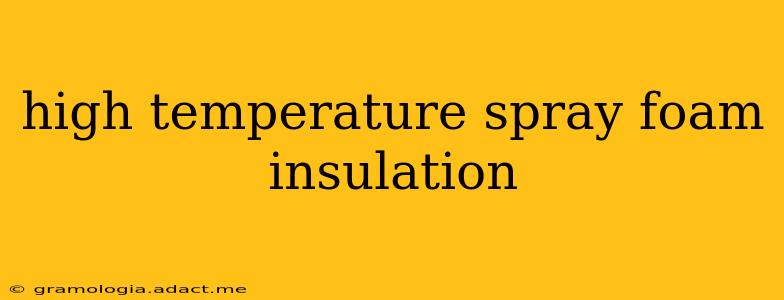Spray foam insulation has become increasingly popular for its superior energy efficiency and air sealing capabilities. However, not all spray foam is created equal. High-temperature spray foam insulation is a specialized product designed to withstand extreme heat, making it ideal for specific applications where standard foam would fail. This comprehensive guide will explore the nuances of this specialized insulation, answering common questions and highlighting its key advantages and considerations.
What is High-Temperature Spray Foam Insulation?
High-temperature spray foam insulation, often referred to as high-heat spray foam, is a type of polyurethane foam specifically formulated to maintain its structural integrity and insulating properties at significantly higher temperatures than standard spray foam. This enhanced heat resistance is achieved through the use of specialized chemical formulations and additives. Unlike standard spray foam which might begin to degrade or lose its R-value at elevated temperatures, high-temperature foam can withstand prolonged exposure to intense heat, maintaining its effectiveness in challenging environments.
What are the benefits of using high-temperature spray foam insulation?
The advantages of high-temperature spray foam insulation extend beyond its heat resistance. Here are some key benefits:
- Superior Heat Resistance: This is the primary advantage. It can withstand temperatures far exceeding those that would compromise standard spray foam insulation. This makes it ideal for applications near furnaces, chimneys, or in industrial settings with high ambient temperatures.
- Excellent Air Sealing: Like standard spray foam, high-temperature foam provides an exceptional air seal, preventing air infiltration and reducing energy loss. This airtight seal contributes significantly to improved energy efficiency.
- Moisture Resistance: High-temperature spray foam offers excellent moisture resistance, preventing the growth of mold and mildew. This is particularly important in applications where moisture is a concern.
- Enhanced Fire Protection (in certain formulations): Some high-temperature spray foam formulations also offer enhanced fire-resistant properties.
What are the common applications of high-temperature spray foam insulation?
High-temperature spray foam insulation finds applications in various settings where extreme heat is a factor:
- Industrial Facilities: Protecting equipment, piping, and structures in industrial settings with high operating temperatures.
- Power Generation: Insulating components in power plants and energy generation facilities.
- Commercial Kitchens: Insulating walls and ceilings in commercial kitchens to minimize heat transfer and improve energy efficiency.
- Fire-Rated Assemblies: In certain formulations, it can be used in fire-rated assemblies to maintain integrity during fire events.
How does high-temperature spray foam insulation compare to other high-temperature insulation materials?
High-temperature spray foam insulation competes with other materials like ceramic fiber, calcium silicate, and mineral wool in high-heat applications. However, spray foam often offers advantages in terms of its seamless application, excellent air sealing, and often superior thermal performance. The choice depends on the specific application, temperature requirements, and budget.
What are the potential drawbacks of high-temperature spray foam insulation?
While highly beneficial, high-temperature spray foam insulation does present some potential drawbacks:
- Cost: It is generally more expensive than standard spray foam insulation.
- Specialized Application: It often requires specialized equipment and experienced applicators to ensure proper installation.
- Limited Availability: High-temperature spray foam may not be as readily available as standard spray foam.
What are the safety precautions when working with high-temperature spray foam insulation?
Working with spray foam insulation, including high-temperature varieties, requires adherence to strict safety protocols. Always follow the manufacturer's instructions carefully and use appropriate personal protective equipment (PPE), including respirators, gloves, and eye protection. Ensure adequate ventilation during application and avoid direct skin contact.
Where can I find high-temperature spray foam insulation?
High-temperature spray foam insulation is typically sourced from specialized insulation suppliers. Contacting insulation contractors or manufacturers directly will help locate suppliers in your region. It's crucial to ensure the chosen product meets the specific temperature requirements of your application.
This information aims to provide a general overview of high-temperature spray foam insulation. Always consult with qualified professionals for specific application advice and to ensure compliance with all relevant building codes and safety regulations. Remember to always prioritize safety when working with any type of spray foam insulation.
